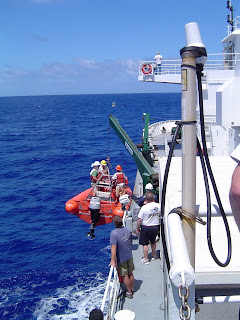NOAA Teacher at Sea: Patricia Kassis
Aboard the R/V KILO MOANA
Date: 10 June 2008
Geographical Area: Central Pacific, North of O’ahu
Science Log
We have remained at the buoy site today. We continue to do the meteorological measurements from the bow (sea surface temperature and humidity), we did a single CTD cast just to test that the instruments were working right for the next cruise, and we've been monitoring the data from the new buoy and comparing them to data the ship is collecting.
The mooring data we've been watching especially closely is the wind direction, which was off before we replaced the anemometer yesterday. And it turns out... the wind direction is still off. The two anemometers still record a difference of about 30 degrees. Although it took a few hours to get the first readings, we were immediately skeptical that the fix had worked because the old "broken" anemometer seemed to be in good working condition when it was brought back on board. The trouble is directional (the instrument's speed measurements are consistent), and it turns out that the compass in each anemometer is influenced by the magnetic field created by the bird wire. Why didn't they think of this? Well, they did, but the bird wire was not supposed to be magnetic. It turns out that we can deflect a compass by bringing it close to some bird wire. This also means that the other anemometer is probably reading an erroneous direction too, as it is surrounded by bird wire also. So the big wigs are bustling around now trying to make an algorithm to correct the wind direction data. In short, we hope the wind direction readings are always deflected by some predictable amount, so we should be able to adjust the data before using it. Shipboard wind measurements will help calculate the errors.
By request, here's a close-up of the meteorological instruments on top of the buoy.
From left to right, they are:
Temp and Humidity sensor (white cylinder with horizontal stripes)
Rain Gauge (white cylinder with opening at the top, black inside; also associated metal cylinder)
Anemometer (with propellers, in the back)
GPS unit for location data (orange)
GPS unit that transmits via Iridium connection (while cylinder)
Barometer for measuring atmospheric pressure (metal cylinder)
A light that flashes orange at night - in the back, here it is covered with black plastic
Four sunlight radiation detectors in the middle (two long-wave, two short-wave)
Second Barometer (metal cylinder)
Second anemometer
Iridium antenna (cylinder with larger diameter)
battery pack (metal cylinder)
second rain gauge
second temp/humidity sensor
The data that these instruments collect are available in nearly real time for the public to see. Right now, the website is still picking up info from the old buoy, which is sitting on deck and, therefore, not making sense. But if you check this WHOI website later on, you should be able to see graphs of barometric pressure (BPR), air temperature (ATMP), water temperature (STMP), wind speed (WSPD), wind direction (WDIR), relative humidity (RH) and so on. Each quantity is measured by two instruments, so each graph has two lines - hopefully they are close; often they are so close it looks like one curve. But let's keep an eye on that WDIR - a good algorithm will place the two curves close together.
Personal Log
Tonight will be our last night at sea. We'll leave the buoy area around sunset tonight and head toward




















